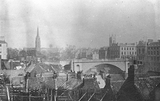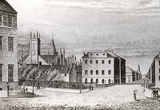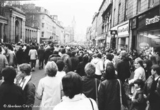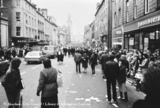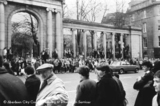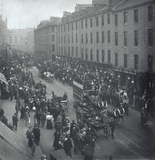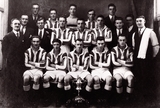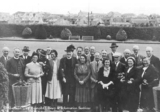|
Quick Search
|
Search Results
You searched for: More Like: 'Aberdeen Football Club parade'
199 items
items as
Crimonmogate House
107 Crimonmogate House, Union Street, prior to its demolition in 1963/64. It stood just west of the Music Hall at the corner of Huntly Street. It was designed by John Smith in 1810 as a town house for Patrick Milne of Crimonmogate, Lonmay, near Fraserburgh. By 1840, it had passed to Sir Charles Bannerman and the original arched entrances to the garden behind were replaced by the wings seen in this photo. From 1874, it was the home of the Royal Northern Club until it moved to other premises in 1955. Plans were submitted in 1959 for its demolition, along with the YMCA next door, to make way for a supermarket. Massey's supermarket was opened in 1965. It was a branch of Somerfield, around 2007, and later Sainburys and the Co-op. Union Bridge from Windmill Brae
123 This photograph by George Washington Wilson, looking towards Union Bridge, shows the old red-tiled roofed houses in the Windmill Brae area in the 1850s. Most of these were swept away with the construction of the railway and the building of Bridge Street around 1865-1867.
The house at the left, on the corner of Union Terrace, was owned by Harry Lumsden of Belhelvie and later by the Northern Club. Its site became part of that occupied by the Northern Assurance Company offices.
The spire of the Triple Kirks and the tower of the South Parish Church are visible in the background. Powis Gateway, Old Aberdeen
165 Powis Gateway, Old Aberdeen. These curious towers stand at the gate leading to Powis Lodge, almost opposite King's College, Old Aberdeen. They were constructed by John Leslie of Powis, who succeeded his father, Hugh Leslie of Powis, the builder of Powis House (1802).
John Leslie succeeded his father in 1812, and the towers were finished in 1834. The crescent on the top of one of the towers is the crest of the Frasers, the predecessors of the Leslies in the property of Powis.
As indicated in the bottom right, this etching of the gateway is by Aberdeen artist Henry Jackson Simpson (1893-1963), known professionally as Jackson Simpson. He was a prolific and successful local artist who specialised in etchings and watercolours of architecture, land and seascapes and wildlife.
Simpson died at his home at 58 Craigton Road, aged 70, on 28th March 1963. His obituary, which gives an account of his life, featured in the next day's Press & Journal.
He was a native of Aberdeen, the son of William Jackson, an art dealer in Diamond Street. He trained as a lithographer and joined his father in business. He served in WWI with the Northumberland Fusiliers and was awarded the Military Cross for bravery.
In 1935 he took over the family business following the death of his father. He was well travelled around Aberdeenshire and Kincardineshire and this is reflected in his art. University related subjects such as Marischal College, King's College and, here, the Powis Gateway, were among his most well known works.
A keen sportsperson, and prominent freemason, he also set-up the Craigton Club and was highly involved with the Northern Arts Club.
An article titled 'The charming story of Jackson Simpson: Scotland's celebrated etcher' featured on the Press & Journal website, in partnership with the McEwan Gallery near Ballater, on 8th June 2022. The feature was produced to highlight an exhibition of Simpson's work at the aforementioned gallery. Deeside Hydropathic
209 Deeside Hydropathic at Murtle, five miles to the west of Aberdeen City Centre, was built for the Rev Dr Alexander Stewart in 1899. He had founded a similar establishment in 1874 at Heathcot, Kincardinshire, and the growth of business there led to the selection of this new site close to Murtle Station on the Deeside Railway. It was also seen as a convenient centre for visiting the Deeside area. The extensive grounds included a croquet lawn, bowling green and tennis courts, while the Deeside Golf Club was only a mile away. The building itself had 92 bedrooms, there were Turkish, Russian, vapour, electric and spray baths. Since hydropathy was a medical treatment consisting of the external and internal application of water, the proximity of an artesian well supplying abundant pure water was also a feature. After the first World War, the building was sold and converted into Tor-Na-Dee Sanatorium in August 1918, specialising in the treatment of tuberculosis. More recently it has been used as a convalescent hospital, but it is now being re-developed for housing. Dr Stewart was born in 1835 in Coupar, Angus and studied at Glasgow University and did the medical course at Aberdeen University. At his death in 1909, he was Minister of John Street Congregational Church in Aberdeen, having been ordained there in 1864. Pittodrie House
270 This photograph shows Pittodrie House which stands on the east slopes of Bennachie near the village of Pitcaple about 20 miles from Aberdeen. The Mither Tap is visible in the background.
Although the house stands over 680 feet above sea level, it is surrounded by trees which provide shelter from the wind. It is a complex house of several dates and was on the estate of the Knight Erskine family for centuries, before being sold in 1903 to George Smith, a Glasgow shipping magnate who founded the City Line of Steamers. The Smith family still own the property which has been run as a luxury hotel since 1977 and the 3000 acre estate is leased for agriculture.
The original house probably dated from around 1490, and a wheel stair from that period still survives, although the house was burnt by Montrose during the Covenanting Wars.
A date stone commemorates the re-building by the Erskines in 1675, and in 1841, the architect Archibald Simpson created the large neo-Jacobean extension with three storey balustraded tower on the east side - seen here covered in ivy. A billiard room was added in the early 1900s and further extensions took place in 1990.
The word 'Pittodrie' is thought to be derived from the Gaelic 'todhar' which can mean either manure or bleach. Aberdeen Football Club's ground is known as Pittodrie Stadium, because the Knight Erskines also owned the lands in the city where the stadium was built. Aberdeen Football Club League Champions 1979/80 parade
342 Aberdeen Football Club League Champions 1979/80 parade down Union Street Gala and Heather Day in the Duthie Park
395 This Adelphi Series postcard shows the Gala Day taking place in Duthie Park on 21st August 1915.
The Gala in Duthie Park and the accompanying Heather Day were both organised to raise funds for the Aberdeen Royal Infirmary.
The Gala Day is one of largest events ever to take place at the park. It was estimated that between 25,000 and 26,000 people attended. Tickets cost 6 pence (6d) for general admission and 2s 6d for carriages or motor cars.
Within the park there was an elaborate programme of entertainment and refreshments organised. Details of the programme were published in a 32 page booklet prior to the event. Upwards of 1,300 people took part in the programme.
Gates to the park opened at 3pm and the event officially commence at 3pm with a grand military parade. Lieut-Colonel A. H. Leith of Glenkindie, Garrison Commander, and Lord Provost James Taggart "took the salute" opposite the Hygiea statue.
The Gala and Heather Day were organised by a distinct committee; Taggart was its president and Alexander Findlay, Superintendent of Cleansing, was its chairman. Councillor H. J. Gray was the secretary and treasurer and Mr John Lints was his assistant. There were also conveners and secretaries for various sub-committees concerned with aspects like entertainment and refreshments.
There was a wide range of entertainment organised for within the park including singing, dancing, gymnastic displays, musical drill, motor cycle gymkhana and bayonet fighting. Various platforms saw performances from acts such as a company lead by D. M. Kinghorn, pierrots directed by Minnie Mearns, Dan Williams, and W. A. Craig's operatic choir. Charles Soutar lead a 500 strong choir of children from the city's public schools.
Practically all naval and military units present in the city were represented at the event and individuals from many of them took part in the sporting competitions. The day also included a 5-a-side football and tug of war competition. Preliminary matches for these took place prior to the day at Pittodrie Park.
The Gala Day was filmed and this was later shown as part of a special programme at the Picture House on Union Street from the 25th of the month.
Over £500 was taken at the gates for the event. Entertainment and refreshments within further increased the figure raised.
Heather Day itself generated another £474. This involved over 1,500 vendors going around all parts of the city selling sprigs of the plant. The sale started on the afternoon of the Friday and continued all through Saturday. Entertainment venues throughout the city were also visited.
The vendors were primarily young women and members of organisations like the boys brigade. Stores present in all areas of the city were replenished from a central depot at 173a Union Street. This in turn was supplied by the cleansing department buildings in Poynernook Road, where the preceding week had seen 200,000 sprigs prepared for sale. Peterhead, Inverurie, Ellon and Banchory organised their own Heather Days for the same fund.
The sum taken from both the Gala and the Heather Day was estimated at considerably over £1,000.
See the report in the Aberdeen Journal, Monday 23rd August 1915 page 8, for further details about the occasion. Frederick Street Primary School roof playground
453 A photograph showing school children on the roof top playground of Frederick Street Primary School in around 1907.
This was one of very few such playgrounds in the city, perhaps one of only two. The Central School on Schoolhill also had a comparable, roof-top playground for at least some of its history.
Frederick Street School opened in 1905 and had a role of 332 infants and 764 senior/junior pupils. The unusual, elevated playground measured 750 square feet. Union Street
634 Towards the middle of the picture can be seen the distinctive square tower of John Smith's West St. Nicholas Kirk House built 1830-31. This drawing is prior to major developments to the junction with Union Terrace, the street on the left of the image.
Note the absence of The Northern Assurance Building on the corner. The building commonly called "The Monkey House" was built in 1885 by architect A. Marshall Mackenzie.
The building at the junction in this drawing is likely the townhouse of the Lumsden family of Belhevie. This would become the first home of the Northern Club in 1854.
In the centre of the image, on the left after Union Bridge, is the Aberdeen Hotel designed by Archibald Simpson and started in 1817. Aberdeen Football Club parade
644 Aberdeen Football Club parade down Union Street after winning the European Cup in 1983. Aberdeen Football Club European Cup parade
645 Aberdeen Football Club European Cup parade up Union Street in 1983. Aberdeen Football Club European Cup parade
646 Aberdeen Football Club European Cup parade up Union Street in 1983 Aberdeen Football Club European Cup parade
647 Aberdeen Football Club European Cup parade up Union Street in 1983 Aberdeen Football Club European Cup parade
648 Aberdeen Football Club European Cup parade up Union Street in 1983 Aberdeen Football Club European Cup parade
650 Aberdeen Football Club European Cup parade up Union Street past the facade of St. Nicholas Churchyard in 1983 European Cup Parade
652 Aberdeen Football Club's open top bus parade of the European Cup Winners' Cup in 1983. The photograph looks north west across Union Street towards its junction with Union Terrace.
Aberdeen defeated Real Madrid 2-1 in the final held in Gothenburg, Sweden on 11th May 1983.
The conquering heroes landed, cup in hand, at Aberdeen Airport at 14.40 the next day. The team received a rousing reception and were given a celebratory cake on arrival from an offshore catering company.
It was then on to the open top bus for the journey from Dyce to Pittodrie. Grampian Fire Brigade lined-up their engines outside their Anderson Drive headquarters as a unique guard of honour for the team as they headed for the city centre.
As shown here, the city streets were packed with fans of all ages, including some who had travelled back from Gothenburg.
Lord Provost Alex Collie, the Queen Mother and Margaret Thatcher all provided messages of congratulations. Celebrations ended at a teeming Pittodrie.
Aberdeen FC had another triumphant tour through the city centre only 10 days later after they beat Rangers 1-0 in the Scottish Cup Final at Hampden Park. The match was on the Saturday 21st May and the parade in Aberdeen was the next day. Aberdeen Football Club parade
662 Aberdeen Football Club parade on Union Street with European Cup, 1983 A parade of trams along Union Street
734 Correspondent Dr Mike Mitchell informs us that this is the celebration of the take over of the Aberdeen District Tramways by Aberdeen Corporation in 1898. The photo was probably taken by Councillor Alexander Wilkie, who is recorded as having gone across the road from the Town House to photograph the parade, and was a Woodside based professional photographer. Culter
876 This image was taken around 1909 from a hill at the west end of Culter - 7 miles west from Aberdeen looking down on the North Deeside Road towards Banchory. The image shows the cottages known as Clayhills with the houses of Malcolm Road beyond. Hidden in the trees at the right hand side is the statue of Rob Roy overlooking the Leuchar Burn which runs through the wooded valley. Culter Football Club
883 A team photograph of Culter Football Club from the 1931-32 season.
Local historian Brian Coutts has been in touch with names for some of the people shown:
The fourth from the left,of the five men in the back row is David Sangster.
The middle row, of nine men, starts on the left with T. Emsie, the club secretary. 4th along is G. Petrie and the 5th is Arthur Jackson.
The front row, starting again from the left, is A.J. Moir, H. Wilson, L. Cooper, W. Jamieson and an unknown 5th man.
Brian also suggests that the trophy at the front might be the Archibald Cup. Newhills Bowling Club
914 Newhills Bowling Club, Burndale Road - left to right, George Youngson, Mr. Christie (fruiterer), Mr. Forbes and Don Sutherland. Newhills Bowling Club
918 Newhills Bowling Club, Burndale Road - bowling match, Newhills v. Aberdeen Presbytery, 1938. 5th/7th Gordon Highlanders parade, Bucksburn
932 5th/7th Gordon Highlanders parade through Bucksburn. |




